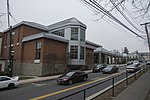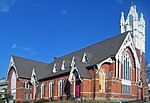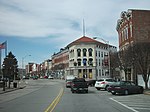Richard Austin House
Gothic Revival architecture in New York (state)Historical society museums in New York (state)Houses completed in 1878Houses in Westchester County, New YorkHouses on the National Register of Historic Places in New York (state) ... and 3 more
Museums in Westchester County, New YorkNational Register of Historic Places in Westchester County, New YorkOssining, New York

The Richard Austin House is located on Croton Avenue (New York State Route 133) in the village of Ossining, New York, United States. It is a wood frame structure dating to the 1870s. In 1989 it was added to the National Register of Historic Places.At the time the house was built, Ossining was beginning its transition from a country town to a commuter suburb of New York City. The Austin House is one of the few from that period of the community's history to remain completely intact, both outside and in, although two extensions were added in the 20th century. It is currently the home of the Ossining Historical Society, which operates a museum in the building.
Excerpt from the Wikipedia article Richard Austin House (License: CC BY-SA 3.0, Authors, Images).Richard Austin House
Croton Avenue,
Geographical coordinates (GPS) Address Nearby Places Show on map
Geographical coordinates (GPS)
| Latitude | Longitude |
|---|---|
| N 41.166944444444 ° | E -73.845833333333 ° |
Address
Croton Avenue 196
10562
New York, United States
Open on Google Maps









